Walking stones in the Valley of Death. Moving stones - a natural phenomenon - the best photos from around the world
Something supernatural is happening in Death Valley. Huge boulders by themselves creep along the bottom of a dry lake. Nobody touches them, but they crawl and crawl. No one saw them moving. And all the same, they persistently creep, as if alive, occasionally turning from side to side, leaving behind them traces stretching for tens of meters. What do these stones need? Where are they crawling? What for?
At that time, most scientists agreed that the most probable hypothesis would be that this phenomenon was caused by strong winds when the soil of the river was minimally wet, and that if this were not the main reason, it would certainly be responsible . However, some stones weigh as much as people do, which led some geologists, such as George Stanley, to believe that such stones would be too heavy to be blown away by the wind. Scientists who follow Stanley believe that the ice sheets around the stones can either help the stone “pick up” more wind, or help the rocks glide over layers of ice on the ground.
In Death Valley, California, there is Lake Racetrack Playa. Its name comes from two seemingly few matching words: English racetrack - "race track" and Spanish playa - "coast".
With the "shore" is more or less clear. The word playa in America is called the lowlands, which after rains are filled with water, thus turning into a lake. When the water begins to gradually descend, the area of \u200b\u200bthe lake decreases, and a shore forms around it. And after a while, when the moisture dries, one shore, in fact, remains.
They searched and marked about thirty stones and used rates to mark their position. Each stone was given a name, and the position of the stones was recorded for seven years. They conducted many trials to try to prove the theory of ice sheets, but this was not proved, the stones moved the same way, regardless of the presence of ice or not. They used fences and boards that should prevent the wind and detect changes caused by freezing. This indicated that if ice is part of this equation, its value should be very small, almost insignificant.
But with the "race track" everything is much more complicated.
Raistrake Playa. You can’t see anything special from the satellite (photo from www2.nature.nps.gov).
The clay bottom of Raistrake Playa is almost always dry, and nothing grows on it. It is covered with an almost uniform pattern of cracks forming irregular hexagonal cells. But there is something else, much more interesting.
Other pairs of stones were selected, and in many of them only one of them moved. It is believed that these gusts are strong enough to be the driving force that initiates the movement of stones, while constant and weaker winds may be responsible for maintaining the movement of stones, since only half of the initial force is required to keep the stone in motion.
But this theory cannot be fully accepted, because the movements of the stones are already recorded at temperatures much higher than the freezing of water, preventing the formation of ice. Rain, cold and wind. How advanced, as human knowledge, but this is not enough to unravel the secrets that pass through our world, because many of them can come from outer space, outside and even from another dimension!
There are stones lying on the bottom - heavy blocks weighing up to thirty kilograms. But in fact, they do not lie there motionless: at times they themselves move, leaving shallow (not more than a couple of centimeters), but very long (up to several tens of meters) furrows on the ground.

Raistrake Playa and the Milky Way above it. But here we are more interested in such strange stripes on the ground, and not this amazing in the sky (photo Dan Duriscoe, U. S. National Park Service). This picture is larger - 1232 × 397 in size.
At this point, the mystery intrigues scientists and geologists: large pieces of stone weighing more than one ton are collected on the dry mud of the soil, and in a fantastic form they move alone. The "walking stones" are not natural for this place, they arrived there after the lake dried up, and the hypothesis that they are meteors falling out of space should be rejected, and not only their exam denies this statement, but they would be fragmented and if he is buried with a blow and does not lie on the scorched earth.
Stones of different sizes are located up to a thousand meters from their original position, leaving traces of various lengths and directions, without any evidence of human or animal interference. How can such heavy stones move? There were those who hypothesized that a wind or some kind of flood caused a displacement of granite blocks.
So far, however, no one has yet seen or removed the movement of these stones on film. But there is no doubt that the stones are moving - the furrows stretch from almost every one of them.
This is not the work of humans or other limbs of any other animals. They didn’t force anyone behind such a strange entertainment (at least until now), because nobody needs these fragments - neither people, nor even animals.
Each stone was given a name and it has been observed for seven years. Protective fences were installed to prevent the effects of winds, but the rocks moved the same way, leading to even more intriguing results; almost all the stones represented movements that ranged from a few centimeters to 262 meters, with a greater distance covered in different directions.
Some stones, selected side by side, showed only one movement, and their pair remained completely motionless. This chaotic scenario made it difficult to find a satisfactory answer. They concluded that moving even the smallest stones would require wind at a speed of at least 500 miles per hour. Despite this, John defends the hypothesis of gliding over ice layers, but this is disputed by many geologists.
For some time there was only one logical suggestion that supernatural forces make crawling stones.
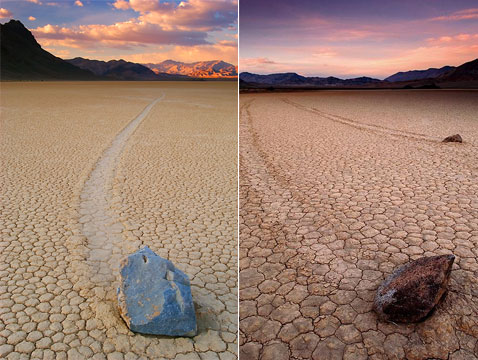
Dashing turns, frozen in clay, and mysterious stones in the middle of a dry lake. For some photographers and Photoshop enthusiasts, this simple story is haunting (photo by Martin Quinn).
Strong winds or geological vibrations necessary for such movement will surely destroy the ice cover under the rocks and cause many visible effects on the landscape. Since the area of \u200b\u200bstones is located in the national park, and wildlife protected by the state, the use of control equipment is prohibited.
An interesting detail: the depth of the grooves where the stones were moved is less than at the points where they went and their current positions, which suggests that "such stones were slightly raised as they moved." The "mystery" of rocks that move in Death Valley, California, in the United States, was finally explained by researchers.
However, at the beginning of the 20th century, scientists appeared from nowhere and said that the reason for the mysterious movement is in some kind of magnetic field. This version had nothing to do with reality, and really did not explain anything.
However, there is nothing unexpected in it: the electromagnetic picture of the world at that time still reigned in science ... But about this, perhaps, some other time.
A riddle was recently discovered that intrigued American researchers. This applies to stones weighing up to 300 pounds and moving in the Death Valley, in the Mojave Desert, California, without human action. Rock formations even leave traces for tens of meters without any machine or system mark that supplanted them. Due to a lack of explanation, some strange theories have arisen. The movement of stones was attributed to the regions of powerful energies, the magnetism of the Earth, and even the actions of aliens.
The scientific explanation came from researcher Richard Norris of the University of California, United States of America and his cousin James Norris. They were able to witness and capture images of moving stones. Although it is an extremely arid region, sometimes rain accumulates in the soil, forming a kind of pool that freezes, and when it melts, it carries stones from side to side.

Plenty of room for imagination! Some tourists try with creeping stones: a) to run a race, b) to play bowling and c) just ride them. The stones themselves, however, patiently ignore all this clowning (photo from wckitto.com).
The first scientific papers describing the trajectories of stones appeared in the late 1940s -1950s. However, this did not help to find out the nature of the movement: all that the researchers were able to do was come up with many new hypotheses, and some of them were very complex.
On a cold desert night, the liquid freezes, forming a layer of ice in which the base of the stones fall into the trap. When the sun appears, the ice begins to break, creating plates that move with the wind. Thus, stones move along clay moving on ice at a speed of two to five meters per minute. According to Richard, this phenomenon is not frequent, because rains in the death valley are not enough, and the average temperature is high.
In the case of this desert, when the ice begins to melt, water flows and causes movement. This is not a continuous stream, like a river, but it provides a moving layer that pulls the stone out of its resting position, ”the specialist explains. This lake is best known as one of the strangest secrets of the planet, namely slippery cliffs. Although no one saw the rocks moving, long, straight or winding tracks left on the surface of lake mud indicate their “activity”. Some of these rocks weigh several tens of kilograms and drove more than 400 meters, leaving us with one question.
In any case, scientists almost unanimously claimed that this strange phenomenon is associated with stormy rains that occasionally occur in the Death Valley, as well as floods following them and everything else connected with it.
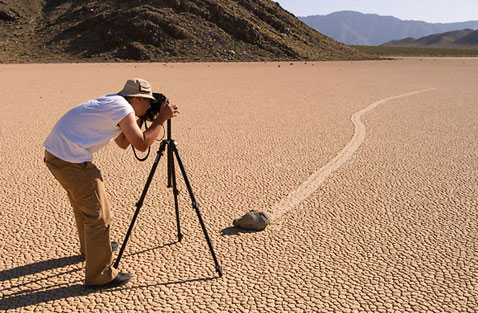
Inexperienced paparazzi prefer to hone their skills on leisurely celebrities (photo by Raymond Soemarsono).
Stones move only every two or three years, and most tracks develop over three to four years. Stones with an uneven underside leave striped and straight traces, while smooth stones meander. Sometimes stones turn around, exposing another ridge to the ground and leaving another trail in its path.
The tracks are all different, both in length and in orientation. Two rocks going side by side will move in parallel until one suddenly changes direction to the left, right, or even backward in the original direction. Despite a century of scientific research, this curious phenomenon has confused geologists and visitors to this place. To date, no one has ever seen how stones move. However, without eyewitnesses, over the years, countless theories have been put forward to explain the reasons for these "walking stones."
Most of the concepts about the movement of these stones (as they just didn’t call them: riding, crawling, swimming, moving, sliding, dancing ... without the Rolling Stones nevertheless did without) came to some common points. So the researchers were able to identify a number of factors that clearly contribute to the movement of blocks.
The first factor is a rather slippery foundation under the stone, in other words, dirt. In favor of this argument, at least the shape of the trace indicates. The paths that the stones leave behind have a clear shape with smooth edges, which means that at first the soil was soft and only then froze.
The first idea suggested that the rocks move under the influence of gravity, gradually sliding along the slope over a long period of time. But this theory was discarded when it turned out that the northern end of the lake is actually a few centimeters higher than the southern end and that most rocks go in that direction.
Very plausible theory: a combination of strong winds and very moist and slippery soil
Although no one has yet been able to definitively determine the cause of the movement of these stones, the woman may have discovered this secret. His research shows that a rare combination of rain and wind allows stones to move. Rain of about 2 cm can wet the surface of the lake, giving it a durable but extremely slippery surface.
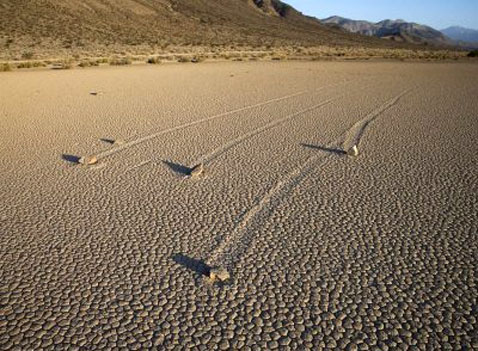
"Hey! Chur, don’t cut! ”(Photo by Angelo Cavalli).
But the slippery foundation is only a condition of mobility. And the main factor due to which the movement begins is the wind, which pushes the stones lying on slimy clay.
However, not everyone supported the idea of \u200b\u200bwind then. For example, geologist George Stanley of the University of Michigan did not believe in it, justifying his opinion that the stones are too heavy to be moved by air masses.
Some people suggested installing a radio transmitter on rocks or installing cameras to take them “during action” in order to stop speculating. But since Death Valley National Park is considered 95% desert, all research in the park should be "non-invasive." It is forbidden to build permanent structures.
To see the moving stones, it is best to come from Las Vegas. Although the lake is located in California, the city of Las Vegas is ready. It is highly recommended to go there 4 times. Off-road driving is prohibited, as the desert is very fragile. Pay attention to the Joshua tree or Joshua trees along the road, which should not be confused with cacti.
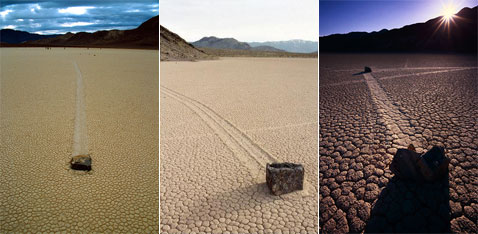
The movement lines of some stones are especially straight ... (photo melastmohican / flickr.com, Roberto Feliciano and from photo-net).
The idea was put forward that the wind was pushing not the stones themselves, but also pieces of ice that were growing on the boulders, and playing the role of a kind of sail, increasing the area of \u200b\u200bcontact with the atmosphere. At the same time, it was assumed that the ice facilitates gliding through the mud.
Keep moving forward. 27 km later you will arrive at the Hippodrome. All the worse for the supernatural, science formally pierced the mystery of the moving stones of Death Valley. Today, scientists at the Scripps Institute of Oceanography in San Diego have finally officially confirmed that these large pebbles are moving, and they have discovered why. What in the middle of the desert can such large stones grow by several hundred meters? The researchers had an intuition that this phenomenon was caused by the general effect of frost and wind, but they had no evidence.
The team of Richard Norris, a professor at the Scripps Institute of Oceanography in San Diego, decided to take matters into their own hands and bring fifteen blocks into the desert in winter. “We expected to wait five to ten years before we see anything moving,” says Richard Norris.
In addition, there were also considerations that earthquakes could have an effect on stone movements. However, this conjecture was quickly rejected quite quickly, since seismic activity is extremely rare in that area, and it is also very weak in order to demonstrate such an effect.
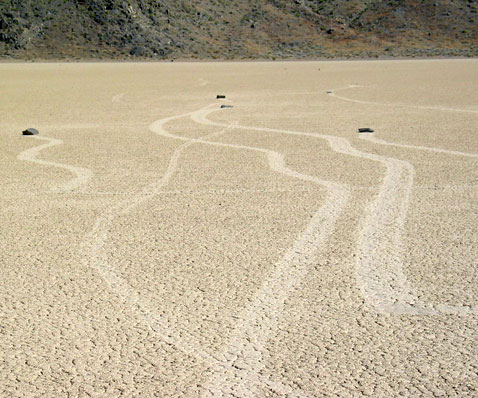
It was then that the stones began to move. Some moved in just a few seconds, but others watched the movement for up to 16 minutes. Up to 60 rocks moved simultaneously, and most passengers traveled 224 meters. All this happened during two and a half months, when the area was covered with a thin layer of ice.
This phenomenon requires special conditions. Playa, a dry type of lake, should be temporarily flooded with enough water to form an ice layer in the harsh winters of Death Valley. Too much water traps the stones during freezing and prevents them from moving. The window is very small, the ice should be three to six millimeters thick.
... And others - not particularly (photo from coordinate-43places.com).
In 1972, Robert Sharp (Robert Sharp), a scientist from the California Institute of Technology (California Institute of Technology), who became famous, by the way, as an expert in the field of surface geologists and Mars, along with Dwight Carey (Dwight Carey), then a student at the University of California in Los Angeles (UCLA), made a breakthrough in the study of this anomaly. For six years, they tracked the movement of stones and learned a lot about this phenomenon. And most importantly, they found out that ice has nothing to do with movement.
The same researchers introduced a nice practice - for the sake of distinction, they began to give the stones names, naturally - feminine.
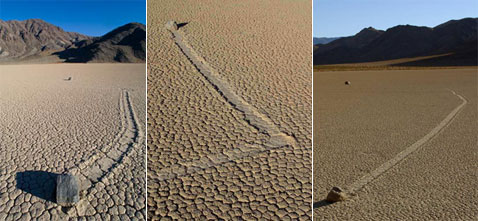
Sometimes stones are painted in such unusual and complex lines that they often turn over, making “somersaults” in the process of movement (photo from goldcoastgalleries.com, as well as Jon Sullivan).
Sharpe and Carey, analyzing the data, created some approximate model. According to her, during the rainy season, water accumulates in the deepening of the lake, and its huge volumes merge into it from the slopes of the surrounding mountains.
This causes flooding, due to which the clay soil is soaking so hard that the coefficient of friction decreases sharply. As a result of this, even Karen, one of the largest stones weighing about 350 kilograms, can move under the influence of wind and travel some distance.

At the bottom of Raistrake Playa there are stones that do not move anywhere. However, they are removed extremely rarely and reluctantly. It is understandable: why take pictures of all sorts of uninteresting bricks? (photo from pdphoto.org).
According to their concept, the movement of stones did not begin during a shower, but after it - because it took some time to soak a rather hard and absolutely dry surface.
Almost twenty years later, when after walking through the Death Valley, Paul Messina, the current professor at the University of San José (San José State University), in 1993 was terribly interested in the stones that she preferred to call dancing (so be it - her right). She became so interested that she began to intensively study all atmospheric and geological matters at the bottom of the Reistrack Playa. And, in the end, she built a dissertation from her research!
![]()
Some stones nearby are moving in parallel, while others are moving in different directions. This fact, noticed by Sharpe and Carey, is evidence of the non-involvement of ice in the process. Stones moving at its expense and located nearby would be invariably frozen into one ice floe and would certainly move together (photo from subversiveelement.com and Daniel Mayer).
The previous researchers could not come to the results that she came to in her work, for Paula used the GPS system for her, tracking the position of the stones with an accuracy of a few centimeters.
She found that, in general, the stones did not move in parallel. In her opinion, this confirms that the ice is irrelevant. In addition, having studied the change in coordinates of as many as 162 boulders, she realized that neither their size nor their shape affect the sliding of the boulders.
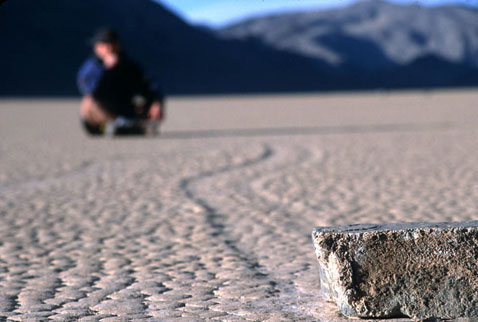
Tourists get here extremely rarely. Firstly, Raistrake Playa is far from any means of communication. And secondly, being here is unsafe. At least because of the same floods that as a result of showers turn out to be so unexpected and severe that sometimes lead to a tragic outcome (photo from geography.sierra.cc.ca.us).
But it turned out that the movement largely depends on what part of Raistrake Playa they are in. According to the model created by the researcher, the wind above the lake behaves in a very complex way.
After the storm, it is divided into two streams, which is associated with the geometry of the mountains surrounding Raistrake Playa. Because of this, stones localized on different edges of the lake move in different, almost perpendicular directions. And in the center, the winds collide and spin in a mini-tornado, causing the stones to spin as well.
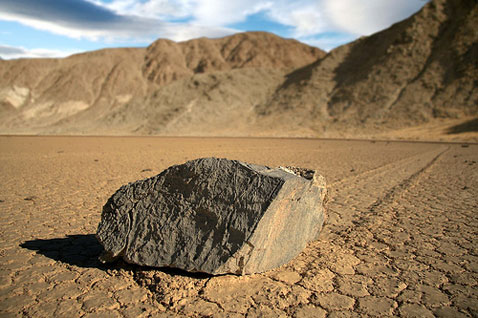
The source of the stones is a dolomite hill in the south of Raistrake Playa and volcanic rock from the adjacent slopes (photo from pdphoto.org).
It is interesting that in the process of movement the stones move significantly, falling under the influence of either one or the other wind, or in general - falling into a vortex in the center.
However, despite the fact that almost every year Professor Messina studies the location of the stones, she still can not answer a number of difficult questions.
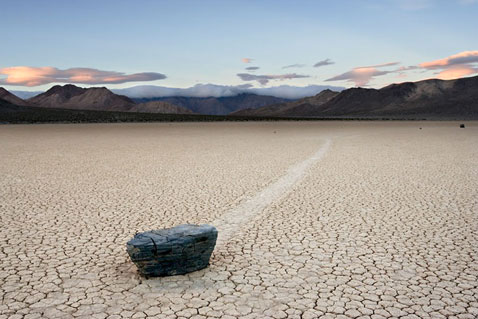
The “paths” from the boulders remain after the bottom of the Raistrake Playa is completely dry. But the boulders themselves remain, by the way, not always. It is known that on several occasions people saw only furrows, which means that for some reason someone has appropriated boulders to themselves. But who and why is unknown. It is possible that for reasons of simple aesthetics - this one, for example, is very pretty. Could look good in our editorial office (photo Dan Mitchell).
Why do some stones move while others stand still? Is this due to the fact that after water drains, the earth in some places is drier than in others? Winds move in narrow or wide streams, and how does this affect stones? Why are the stones "scattered" all over the bottom of the lake, while as a result of such regular winds directed almost always the same, the bulk of the blocks should be at one of the edges? Is this due to the fact that the stones somehow "come back" back, or is it simply for some reason that people take them? And at what time do stones move more often: in winter, when there is most rainfall, or in summer?
A lot of obscure, a lot ...
Eh, it’s a pity that the stones cannot speak ... Although, as you know, from these boulders, it seems, one might expect not so.
American scientists have been able to figure out how stones lying at the bottom of a dried reservoir in Death Valley can move. Researchers even managed to see this amazing process.
For a long time, science could not give an exact answer to the question of how the stones move along the bottom of Lake Reystrake Playa, which is part of the American Death Valley National Park. By itself, the geological phenomenon of moving stones is found in other places on our planet, however, the number and length of the tracks of Raistrake Playa stands out from the rest.
Most stones fall to the bottom of a dried lake from a nearby 260-meter hill. Their weight reaches several hundred kilograms. The tracks that follow them have a length of several tens of meters, a width of 8 to 30 cm and a depth of less than 2.5 cm. The stones come into motion only once in two or three years, and the tracks usually remain for 3-4 more of the year. Stones with a ribbed bottom surface leave more direct traces, and stones lying on the flat side wander from side to side. Sometimes stones turn over, which affects the size of their footprint.
Until the beginning of the 20th century, the phenomenon was explained by supernatural forces; during the formation of electromagnetism, an assumption arose about the effect of magnetic fields, and full-fledged research began in 1972. Then a theory was developed according to which water that accumulates during the rainy season in the southern part of the lake is carried by the wind along the bottom of the dried lake and moistens its surface. As a result, hard clay soil becomes very soft and the coefficient of friction decreases sharply, which allows the wind to budge even a 300-kilogram stone.
The version was also considered that the stones glide over the ice crust that forms here in winter. However, none of the theories explained why the stones standing nearby can move in different directions. It is also unclear why the stones are "scattered" around the bottom of the lake, while the winds would move them to one of the edges of the reservoir.
One of the difficulties in the research process is the status of the conservation area of \u200b\u200bthe Death Valley. But not so long ago, American scientists from the Scripps Institute of Oceanography managed to conduct an experiment on the ground: the park administration did not allow the use of genuine stones, and then stones identical to the present were placed on the bottom of the lake. Each of them was equipped with cameras and navigation sensors.
Two years later, in December 2013, scientists noticed that the bottom of the lake was covered with a layer of water several centimeters high. It was after this that the movement of stones began. The hypothesis with the wind was completely rejected: the stones moved in relatively calm weather.
The reason for the movement was large, up to tens of meters, but very thin sections of ice formed after freezing in the previous frosty nights. Floating and melting ice moves stones at speeds up to 5 meters per minute.
